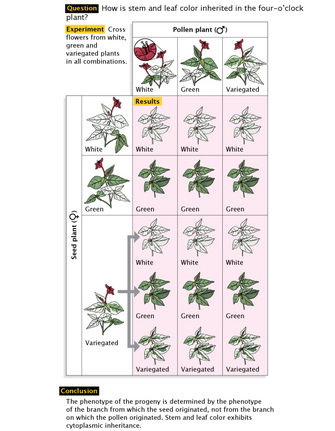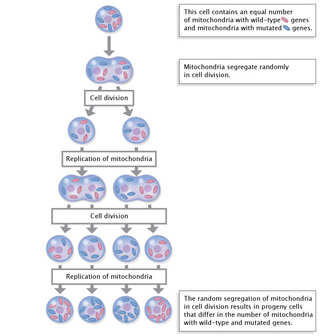« Prev Next »
Offspring inherit a combination of nuclear chromosomes from each of their parents as a result of fertilization. However, it turns out that some genes are passed on from parent to offspring without ever being part of a nuclear chromosome. Where are these genes found, and how does the transmission of such genes occur? Moreover, why do some of these genes appear to be inherited solely from the maternal parent, while others come solely from the paternal parent? The answer lies within cells' cytoplasm.
Uniparental Modes of Inheritance

How Uniparental Inheritance Works
But why is leaf color in Mirabilis determined by only one parent—in this case, the maternal parent? The answer to this question lies in the location of the gene that determines leaf color.
In order to understand what this means, it is first important to note that plant progeny inherit their cytoplasm almost exclusively from the maternal parent. This cytoplasm is full of cellular organelles, including chloroplasts, which function in part to make plants green. Moreover, while transmission genetics concentrates mostly on the inheritance of nuclear chromosomes, there is also genetic material in the cytoplasm of gametes—completely separate from the nucleus—that goes along for the ride when fertilization occurs. These genes are inside cellular organelles, such as chloroplasts and mitochondria, which have their own patterns of self-replication. When these nonnuclear genes are passed from one generation to the next, the phenomenon is called cytoplasmic inheritance.
The inheritance pattern of Mirabilis leaf color demonstrates that the genes responsible for making chloroplasts come from nonnuclear DNA that resides in chloroplasts, known as chloroplast DNA (usually abbreviated cpDNA). In fact, white leaves or any white patches on a leaf are caused by cells that carry a defective gene in their cpDNA. In Mirabilis, not only is this cpDNA passed on to progeny through the cytoplasm, but it also comes only from the maternal gamete; this occurs because Mirabilis pollen grains, which are the paternal gametes, do not contain any chloroplasts. Correns's hypothesis was therefore correct.
Nonnuclear Inheritance and Mendelian Patterns
But why didn't Correns see Mendelian ratios deriving from seeds on Mirabilis variegated branches? It turns out that nonnuclear inheritance does not follow patterns of independent assortment and segregation, because these patterns are the consequence of nuclear chromosome lineup during gametogenesis. Rather, cytoplasmic contents (and therefore the nonnuclear genes within them) are squeezed into subcompartments at random during the formation of Mirabilis's maternal gametes. Furthermore, this cytoplasm is not distributed equally among gametes, which results in variable numbers of organelles in each gamete. Specifically, in the flowers from variegated Mirabilis branches, the random aggregation of chloroplasts during oogenesis produces some egg cells with normal cpDNA, which develop into green progeny; other egg cells with abnormal cpDNA, which develop into white progeny; and still other egg cells with a mixture of normal and abnormal cpDNA, which develop into variegated progeny.
Correns's work with Mirabilis sparked a whole field of research on cytoplasmic inheritance. The more we learn about cytoplasmic inheritance, the more complex it becomes. For example, though we often assume that donor cytoplasm is always maternal, there is evidence of paternal cytoplasmic inheritance in plants other than Mirabilis. Cycads and ginkgos, for instance, have motile sperm that can carry chloroplasts straight into an egg. But is cytoplasmic inheritance always uniparental? Quite simply, the answer is no. Cross-pollination of different species of Passiflora demonstrates that patterns of inheritance in these species' chloroplast genome are both paternal and maternal. However, such inheritance still does not look like nuclear inheritance.
Biparental Inheritance
With modern DNA analysis techniques, scientists can actually trace inheritance by looking directly at markers on genes in parents and progeny after a test cross, rather than doing multiple backcrosses. In fact, exploring issues of heredity in this way can help us understand how organisms are related throughout evolution. And this is exactly what biologist A. K. Hansen and her colleagues were trying to understand when they used DNA screens to measure the inheritance of the chloroplast genome in different species of Passiflora (Hansen et al., 2007). Through their research, the team found that all interspecific crosses (crosses between species) had primarily paternal chloroplast inheritance, while nearly all intraspecific crosses (crosses within the same species) had primarily maternal inheritance. According to these results, mating outside the species is somehow detected at the germ cell level, and a choice is made to switch to paternal chloroplast inheritance.
However, one intraspecific cross really stood out among all others. In this cross, three out of 15 progeny showed biparental chloroplast inheritance, also known as heteroplasmy, while the remaining 12 showed maternal inheritance. Though it was (and still is) unclear how this heteroplasmy occurred, it was surprising that two modes of inheritance could exist simultaneously in the progeny of just one cross! The experiments of Hansen et al. have thus demonstrated that new rules about cytoplasmic inheritance emerge all the time.
| Passiflora Species Crossed | Number of Progeny | Mode of Chloroplast Inheritance in Progeny |
| P. costaricensis x P. costaricensis (intraspecific) | 15 | 12 maternal, 3 biparental |
| P. oerstedii x P. retipetala (interspecific) | 17 | 17 paternal |
(Table excerpted from Hansen et al., 2007)
Mitochondrial Inheritance

The first people to capture images of DNA "fibers" in mitochondria were Margit and Sylvan Nass in 1963. With a powerful electron microscope, they were able to zoom in on part of a mitochondrion and take a photograph at a magnification of 150,000X. In doing so, the Nasses noticed a black threaded material inside mitochondria that would disappear after exposure to an enzyme (deoxyribonuclease) that specifically dissolved DNA. This was the first visual and chemical evidence that DNA existed in mitochondria.
Since the Nass experiments, interest in mtDNA has expanded greatly. Scientists now know that within a single cell, there can be thousands of mitochondria, and each mitochondrion contains from two to ten copies of mtDNA. During cell division, the mitochondria aggregate randomly into progeny cells. This means that each cell can theoretically contain a different mixture of normal mtDNA and mutated mtDNA, which can in turn generate a variety of phenotypes (Figure 2). But are these mtDNA mutations anything more than a sideshow to the main events of nuclear function? Indeed they are. Mutations in mitochondria can have very serious effects, and they are even the basis for several diseases. Mitochondria's crucial role as the main producer of ATP within cells means that malfunctions in these organelles are truly bad news.
Extranuclear inheritance of mitochondria has been tracked in families that carry defective mitochondrial genes. Some of the diseases caused by defective mitochondria particularly affect muscle tissue, as muscle uses ATP and mitochondria are cellular producers of this substance. One such condition is an inherited disorder called progressive external ophthalmoplegia (PEO). Spelbrink et al. (2001) analyzed multiple pedigrees of families affected by PEO, and they analyzed the mitochondrial genes along with the inheritance pattern of the disease. Eventually, the researchers noticed that the mtDNA of those individuals affected with PEO showed many more deleted sequences than the mtDNA of unaffected individuals. Next, the team tried to figure out what these deletions meant for mitochondrial function. After taking blood samples from 12 different families affected with PEO, they extracted mtDNA from blood lymphocytes and screened it for common patterns in affected and unaffected individuals. They found that PEO carriers had 11 different deletions in the coding sequence for a mitochondrial protein that appeared to be involved in mtDNA replication. They named this protein Twinkle, because it is distributed all over mitochondria like a constellation pattern in the night sky. The investigators concluded that Twinkle is likely a DNA helicase protein involved in maintaining the integrity of mtDNA as it replicates. Therefore, although Twinkle is encoded by nuclear DNA, it affects the transcription of mtDNA (Spelbrink et al., 2001). In other words, when it comes to PEO, both nuclear and mitochondrial DNA are involved in the inheritance of a single disease.
Emerging Discoveries in Cytoplasmic Inheritance
At first glance, the inheritance of nonnuclear genes appears to follow a random pattern of cytoplasmic matter separation. But as we examine this mode of inheritance more closely, new patterns emerge that betray that far more complex processes affect the transfer and maintenance of the organelle genome. It has also become clear that mtDNA may have a close relationship with nuclear genes, and that the integrity of mtDNA may be related to actions coordinated by the cell nucleus.
Overall, nonnuclear inheritance is characterized by random patterns of distribution in progeny that appear to follow an entirely different set of rules we are only beginning to understand. In fact, some inheritance patterns are not always due strictly to DNA, nuclear or otherwise. For example, the direction of coiling in snails is determined by a nonuniform distribution of cytoplasmic factors in the early embryo. Early cell divisions result in irregular distribution of these factors in the embryonic cells, which has been linked to the inheritance of left- or right-handed coiling (Gilbert, 2006).
Together, all cellular sources of DNA and the intracellular factors that are inherited from parent to offspring interact to influence the heredity of traits. The complexity of all these parts working together makes inheritance relevant even today. Mendelian principles helped guide the way for understanding the basic inheritance of alleles, but the complexity of how genetic, epigenetic, and environmental factors intertwine to control distinct phenotypes continues to be explored by scientists every day.
References and Recommended Reading
Birky, M. Uniparental inheritance of mitochondrial and chloroplast genes: Mechanisms and evolution. Proceedings of the National Academy of Sciences 92, 11331–11338 (1995)
Chen, X. J., & Butow, R. A. The organization and inheritance of the mitochondrial genome. Nature Reviews Genetics 6, 815–825 (2005) doi:10.1038/nrg1708 (link to article)
Correns, C. Vererbungsversuche mit blass (gelb) grünen und buntblättrigen Sippen bei Mirabilis, Urtica und Lunaria. ZIAV 1, 291–329 (1909)
Gilbert, S. Developmental Biology, 8th ed. (Sunderland, MA, Sinauer, 2006)
Hansen, A. K., et al. Paternal, maternal, and biparental inheritance of the chloroplast genome in Passiflora (Passifloraceae): Implications for phylogenetic studies. American Journal of Botany 94, 42–46 (2007)
Moraes, C. A helicase is born. Nature Genetics 28, 200–201 (2001) doi:10.1038/90020 (link to article)
Nass, M. M. K., & Nass, S. Intramitochondrial fibers with DNA characteristics. I. Fixation and electron staining reactions. Journal of Cell Biology 19, 593–611 (1963)
———. Intramitochondrial fibers with DNA characteristics. II. Enzymatic and other hydrolytic treatments. Journal of Cell Biology 19, 613 (1963)
Pierce, B. Genetics: A Conceptual Approach, 2nd ed. (New York, Freeman, 2005)
Spelbrink, J. N., et al. Human mitochondrial DNA deletions associated with mutations in the gene encoding Twinkle, a phage T7 gene 4-like protein localized in mitochondria. Nature Genetics 28, 223–231 (2001) doi:10.1038/90058



 Figure 1: Experiments by Carl Correns introduced concepts of non-nuclear chromosomal inheritance.
Figure 1: Experiments by Carl Correns introduced concepts of non-nuclear chromosomal inheritance.


























